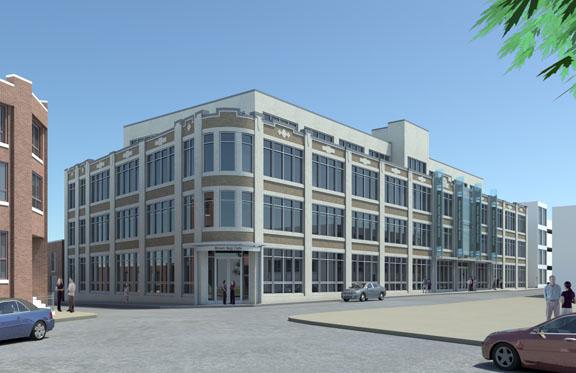PROVIDENCE, R.I. [Brown University] — Brown University President Ruth J. Simmons and Edward J. Wing, M.D., dean of medicine and biological sciences, welcomed guests at the groundbreaking ceremony for the new home of the Warren Alpert Medical School of Brown University in Providence’s historic Jewelry District. The ceremony, at noon Monday, April 26, 2010, included remarks from Gov. Donald L. Carcieri, Providence Mayor David N. Cicilline, and Michael F. Sabitoni, president of the Rhode Island Building and Construction Trades Council.
The Alpert Medical School plan includes a $45-million renovation that will transform the building into a modern glass structure featuring lecture halls, an anatomy lab, and case study and seminar rooms. Ellenzweig Associates created the designs for the approximately 135,000 gross-square-foot project, which incorporates the existing structure to meet the University’s commitment to sustainability and environmentally friendly practices. When completed in August 2011, the building will be a focal point from many areas in Providence, especially at night, with the illumination through the glass structure. The medical school building will also be an attractive and highly visible feature of the new cityscape that is part of the 195 highway reconstruction project.
“We are entering an exciting next phase for our medical school,” Simmons said. “This building will allow us to foster greater interaction among faculty and students, connect more easily with the greater community, and continue Brown’s commitment to learning and innovation.”
The building, at 222 Richmond St. in the Jewelry District, will establish a central learning and practice facility for the next generation of doctors and will facilitate interaction among students, residents, fellows and faculty. The medical building will also allow the school to implement an academy system of learning, intended to enhance personal and formal education by grouping students into one of three academies overseen by a faculty mentor.
“We are a relatively young medical school, which makes the success we have achieved remarkable,” said Wing. “With this expansion, we can better meet our mission to educate future doctors, focus on a patient-centered approach to care with a sense of social responsibility, and foster new knowledge.”
The creation of the medical school building comes during a time of historic changes to the U.S. health care system. The government estimates that an additional 32 million people will have health insurance based on recent legislation. At the same time, the American Medical Association estimates that by 2025 the United States will be 150,000 doctors short of the number needed. The Alpert Medical School is working to fill that gap; the new facility will allow the medical school class size to increase from 96 to 120 students.
“We are committed to educating the next generation of doctors to meet the immediate and emerging challenges and opportunities of our healthcare system,” Wing said. “This facility will give us the chance to increase our student body, which will help the larger community in years to come.”
The building is expected to generate $26.2 million of economic output for the state, create nearly 350 temporary construction and retail jobs, and support an additional 200 jobs, according to an independent 2009 economic impact study conducted by Appleseed Inc. In Rhode Island, the total economic impact of academic medicine in 2008 exceeded $4 billion and accounted for 28,249 jobs. The out-of-state medical visitor impact was $139 million. The state government revenue attributable to academic medicine in 2008 was $218 million.
The Warren Alpert Medical School will occupy a place of historic and economic importance to Rhode Island. Between the late 19th and early 20th centuries, the Jewelry District emerged from what had been the West End of Providence. For 50 years, the building at 222 Richmond St. was the headquarters of the Brier Manufacturing Company, which manufactured Little Nemo jewelry. This area is emerging as the Knowledge District, which houses a number of life sciences, health care and biotech companies. The Alpert Medical School will serve as a cornerstone to this district, continuing the city’s expansion into a knowledge economy.

